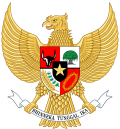Fourth Working Cabinet Kabinet Kerja IV | |
|---|---|
| 22nd Cabinet of Indonesia | |
| 1963–1964 | |
 | |
| Date formed | 23 November 1963 |
| Date dissolved | 27 August 1964 |
| People and organisations | |
| Head of state | Sukarno |
| Head of government | Sukarno |
| No. of ministers | 61 ministers |
| History | |
| Predecessor | Working III Cabinet |
| Successor | Dwikora I Cabinet |
| ||
|---|---|---|
Pre-independence Domestic policy Foreign policy Family | ||
| Gallery: Picture, Sound, Video | ||
The Fourth Working Cabinet (Indonesian : Kabinet Kerja IV) was an Indonesian cabinet that resulted from regrouping of the previous cabinet by President Sukarno. It consisted of three deputy prime ministers, eight coordinating ministers, 33 ministers, six ministers of state, as well as 11 cabinet members who headed various government bodies. It was dissolved on 27 August 1964.
Contents
- Composition
- Cabinet Leadership
- Presidium
- Foreign and Foreign Economic Relations Section
- Justice and Home Affairs Section
- Defense and Security Section
- Finance Section
- Development Section
- Distribution Section
- Welfare Section
- Relations with the People Section
- Presidential Advisory Ministers
- Leaders of State Bodies Ministers with Ministerial Status
- References

